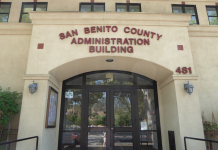Hollister
– Gas prices are still rising and some Hollister motorists are
changing their ways behind the wheel. Others, though, still enjoy
the thrill of a speedy acceleration.
Hollister – Gas prices are still rising and some Hollister motorists are changing their ways behind the wheel. Others, though, still enjoy the thrill of a speedy acceleration.
Gas prices jumped 8 cents in two weeks, continuing a market trend that has seen prices double in four years and stay above $3 per gallon in the last three months, according to a July gas report by AAA.
One local motorist is adapting.
“I’m taking this in to trade it for a Honda Civic,” said Wade Wellington, as he filled up his six-cylinder Ford Explorer. “Forty miles to the gallon.”
Another resident is shrugging it off.
“I think they suck on an engine like this,” said Sue Amaral about the prices, pointing to her brand new V8 Dodge Charger. “But in a split second, she hauls ass.”
The AAA report tallied the average statewide price for a gallon of gas at $3.26. Drivers in South Lake pay the highest at $3.40 per gallon. Some stations in Hollister, such as Safeway Gas and One Stop Gas and Food, are tied for the lowest at $3.13 per gallon with Pleasanton and Vallejo. California’s statewide average record was $3.38 per gallon in May, according to the report.
“I think its easy to get lost in the details of 8 cents here or 8 cents there,” said Sean Comey, of AAA Northern California.”But it’s the fact that gas prices have doubled in the last four years.”
One of the best options for consumers, Comey said, is to send the oil companies a message by conserving or exploring alternative sources, such as hybrid technology or biodiesel.
“You can send a message by using your hard-earned money to buy less of their product,” Comey said. “Ask people who are running for elected office what their plans are for energy policy.”
That’s easier said than done for thousands of commuters, though, such as Hollister resident Andrea Juarez, who works nights at Gavilan College in Gilroy. It’s not a long drive, she said, but it’s still costing her $60 to fill up twice a week.
“I don’t like it,” she said. “It puts a damper on your wallet. And then you want to go out of town on the weekend – it’s not even worth it.”
And don’t think the high price at the pump is benefiting retailers; they’re feeling the squeeze, too.
Zaim Faquiryan, manager of City Gas and Food Mart in Hollister, blamed the oil companies.
“They’re looking for every excuse to jack up the price,” he said. “It used to be good, but since 2001, it’s kind of messed up. I’m trying to get out any way I can.” His father owns the gas station.
Comey highlighted four principles that dictate market trends in oil and gas: Taxes, retail prices, refinery capacity and crude oil supplies.
“The most volatile are refining and crude oil,” he said.
Political instability in oil-producing countries such as Iraq and Nigeria can cause oil prices to soar. And a lack of refinery capacity, such as in California and post-Katrina Louisiana, can create a bottleneck between suppliers and consumers, jolting prices higher. Comey said some California refineries have expanded, loosening up the flow a bit. But building new refineries is far more difficult, he noted.
“What community wants a refinery built in their backyard?” Comey said.
For more information on AAA’s work on gas conservation and alternative fuels, go to www.aaa.com/greenlight.
Banks Albach covers local government for the Free Lance. Reach him at 831-637-5566 ext. 335, or ba****@***********ws.com.









